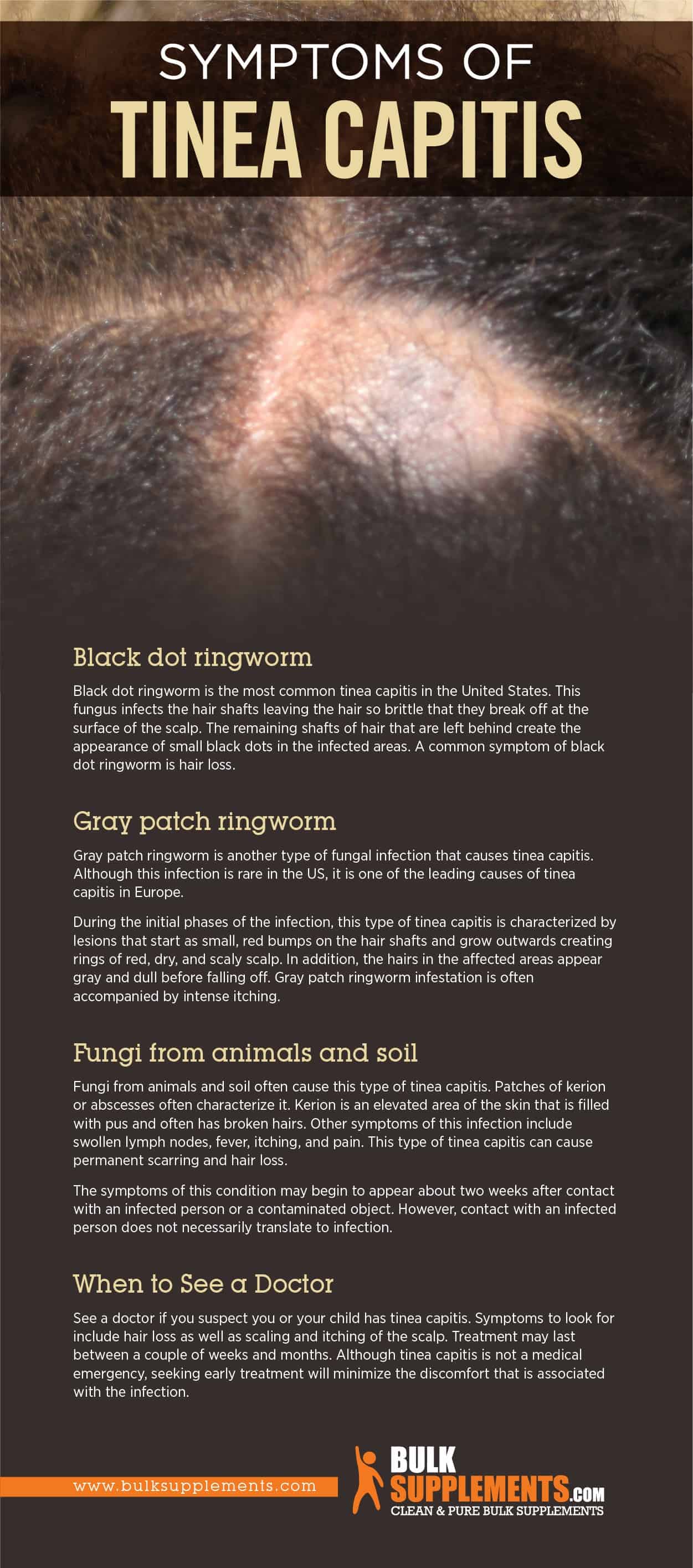Tinea Capitis (Ringworm of the Scalp): Causes, Symptoms & Treatment

Tinea Capitis
What is Tinea Capitis?
Tinea capitis is a skin disease caused by a fungal infection. This condition usually affects the scalp, eyelashes and eyebrows. The fungus that causes this infection attacks hair shafts and hair follicles. Sometimes physicians refer to this infection as ringworm of the scalp and tinea tonsurans. However, tinea is a group of fungal diseases. The names of the condition differ depending on where the infection develops on the body. For example, tinea capitis is a scalp infection while tinea pedis is an infection on the feet, commonly called athlete’s foot.
Although tinea capitis is called ringworm of the scalp, it is not a result of worms, but a fungus. The infection forms circular marks on the scalp with flat centers and raised borders. The pattern is what gives the condition its name. Tinea capitis is highly contagious and often spreads from one person to another by sharing combs, hats, towels and pillows. Although it is most common in children, tinea capitis can affect people in all age groups.
Symptoms of Tinea Capitis
The appearance of tinea capitis varies among individuals. However, the infection has common symptoms. The scalp is usually red and crusty and the infected areas usually have an intense itch. It may also cause hair loss. Some children experience swollen lymph nodes or a fever.
Types of Tinea Capitis
The symptoms of tinea capitis may differ depending on the type of fungus that caused the infection.
Black Dot Ringworm
This is the most common tinea capitis in the United States. It comes from the Trichophyton (T. tonsurans) organism. The fungus infects the hair shafts, leaving the hair so brittle that it breaks off at the surface of the scalp. Hair loss is a common side effect. The remaining shafts have small black dots on the infected areas.
Gray Patch Ringworm
Gray patch ringworm is another type of fungal infection, from the organism Microsporum. Although it is rare in the U.S., this particular fungus is one of the leading causes of tinea capitis in Europe.
During the initial phases of the infection, this bacteria causes lesions that start as small, red bumps on the hair shafts. They then grow outward, creating red, dry and scaly rings on the scalp. The hair on the affected areas is gray and dull until it falls off. Patients with gray patch ringworm infestation often have intense itching.
Inflammatory Ringworm
This type of ringworm often comes from fungi from animals and soil. It causes areas of inflammation with pus-filled abscesses. The patient may also notice elevated masses with broken hairs that discharge pus, called kerion formations. This type of tinea capitis can cause permanent scarring and hair loss.
It may cause swollen lymph nodes, fever, itching and pain on the skin. The symptoms may begin to appear about two weeks after the patient contracts it from an infected person or contaminated object. However, contact with an infected person does not necessarily translate to infection.

Causes of Tinea Capitis
A fungus causes tinea capitis. Fungi are microorganisms that can survive on dead tissue. They can live in dead tissue in the hair, fingernails and the outer layers of the skin. Specifically, the fungi that cause ringworm of the scalp are called dermatophytes because they need keratin to grow, which is in the skin, hair and nails. They prefer warm and moist environments. Therefore, they thrive on sweaty skin. Poor hygiene and overcrowding increase the chances of spreading the infection.
Ringworm is extremely contagious. The fungi can spread through contact with an infected person or contaminated objects, such as bedding, public seats, hats, combs, hairbrushes and clothing. However, contact alone may not always cause an infection. The fungi that cause tinea capitis affects humans, but it can also infect dogs, farm animals and soil.
Risk Factors for Tinea Capitis
Ringworm mostly affects children between 4 and 14 years old. However, younger children and adults can also get infected. Tinea capitis is a common infection in urban areas with poor hygiene, damp climates and overcrowded housing units. In addition, it is more severe in people with weak or compromised immune systems such as those with HIV/AIDS, cancer and diabetes.
When to See a Doctor
See a doctor if you suspect that you or your child may have tinea capitis. Symptoms to look for include hair loss as well as scaling, pain and severe itching on the scalp. Although tinea capitis is not a medical emergency, seeking early treatment will minimize discomfort and avoid complications like permanent scars and hair loss.
Diagnosing Tinea Capitis
In most cases, doctors use a physical exam to diagnose tinea capitis. During the exam, the physician may examine the patient’s scalp with a wood lamp that transmits UV light. When the light hits the base of the hair shaft, it emits a blue-green fluorescent light that indicates the presence of fungi.
The doctor can also diagnose tinea capitis with a simple visual inspection, taking note of the patient’s symptoms. They may also scrape pieces of the scalp with a surgical blade to analyze in a laboratory. The patient may have to undergo this procedure more than once to make sure the infection is clear. The doctor may also use cotton swabs, a toothbrush or moistened gauze to collect tissue samples from the scalp.
Treatment for Tinea Capitis
Usually ringworm is not a serious condition, but it can cause discomfort. Luckily, the condition is treatable. A doctor may prescribe antifungal medication in oral pills or shampoos, such as griseofulvin and terbinafine hydrochloride. However, these antifungal medications may cause some side effects, including diarrhea, upset stomach, fatigue and vomiting. Patients may also experience headaches, rashes, hives and sensitivity to the sun.
Medicated Shampoo
Doctors may also prescribe medicated shampoo to treat tinea capitis and prevent the infection from spreading. Most medicated shampoos contain ketoconazole or selenium sulfide as the active ingredient. Although medicated shampoos help prevent the fungus that causes tinea capitis from spreading, they do not kill the microorganisms. Therefore, patients should combine this treatment with oral medication.
Recovery and Reinfection
With medication, ringworm may take up to a month to heal, depending on the extent of the infection. Therefore, it is essential to be patient and take all medications that a physician prescribes and follow their directions. After four to six weeks, the doctor may recommend a follow-up exam to check if the infection is healing. Getting rid of tinea capitis can be difficult and it’s possible to contract the infection more than once. Tinea capitis can cause a few long-term complications, including bald or scarred patches on the scalp.
If a patient believes they—or their children—may have tinea capitis, it’s a good idea to have any pets or farm animals checked and treated as well. In addition, avoid sharing personal items like hats, combs and towels. Sterilize the hairbrushes and combs that infected family members use on a regular basis to prevent the infection from spreading.
Supplements for Tinea Capitis
Taking natural supplements are another option that patients can use to fight off infections. Supplements that boost the immune system may even help prevent the infection in the first place. However, supplements are not a replacement for medical treatment or medical advice. Always consult a physician before starting a supplement regimen.
SEE ALSO

Ectopic Pregnancy: Characteristics, Causes & Treatment
Green Tea
Green tea is rich in a type of antioxidant called polyphenols that help the body fight off infections and protect it from disease. According to research, polyphenols help increase the existing antioxidant levels in the body. It can help relieve inflammation and also benefit the skin, possibly treating conditions like acne, rosacea and warts. It may also help the skin heal from a fungal infection like ringworm. The recommended dosage for green tea extract as a dietary supplement is 500 to 1,000 mg per day. However, patients should never exceed 1,000 mg a day.
Biotin (Vitamin B7)
Vitamin B7, also called biotin, is a water-soluble vitamin. It benefits metabolism and helps regulate genes and cell signaling. Biotin supplements promote healthy skin, nails and hair. Research shows that it helps keep the nails firm and thick and keeps the skin smooth. Studies show that it may even help reduce hair loss, which is a possible complication of ringworm on the scalp. If a patient with ringworm begins to lose their hair, biotin supplements may help it regrow. As a dietary supplement, take biotin 1% (Vitamin B7) in 100 mg doses per day.
Potassium
With a fast absorption rate and a high essential mineral content, potassium contributes to a number of different processes in the body. The human body contains an abundant amount of potassium and 98 percent of it is in the body’s cells. It is the main electrolyte in the body that helps maintain fluid regulation and keep the cells healthy. Most of the time, people get potassium from their diet, including bananas, oranges, cooked spinach and nuts. However, it is also available as a supplement that can ensure a consistent dosage.
As a dietary supplement, take 275 mg of potassium citrate powder per day, unless a doctor recommends a different dosage. Use an accurate milligram scale to measure the serving size because an overdose can cause stomach upset and flatulence. Stop taking this supplement if you experience an allergic reaction such as a rash, difficulty breathing or dizziness.
Oregano
Free of fillers, artificial flavors and synthetic chemical residue, oregano extract has several different potential health benefits. Research shows that it may help manage the symptoms of various diseases, including colitis and candida, as well as bacterial and fungal infections. Specifically, carvacrol, a natural phenol, is the main ingredient in oregano. It has anti-inflammatory, antiseptic and antifungal characteristics that may help fight fungal infections like tinea capitis.
The safe dietary serving size for oregano extract powder is 500 mg up to three times per day with meals, unless a physician recommends a different dosage. The product may cause mild stomach upset, but it often does not last. Oregano extract may also cause allergic reactions in patients with an allergy to related herbaceous perennial plants, such as mint.
Grapefruit Seed
People recognize the grapefruit for its bittersweet citrus taste. But grapefruit seeds are also a wonderful ingredient that promote overall health. It is full of antioxidants that fight free radicals that can cause disease. It also has powerful natural antibacterial and antifungal properties. Studies show that it is capable of fighting fungal infections like candida and even athlete’s foot, another type of tinea infection. As a supplement, the recommended dosage for grapefruit seed extract is 500 to 1,000 mg up to three times per day before a workout.
The Bottom Line
Tinea capitis is a highly infectious fungal infection. Its most common name is ringworm of the scalp. It affects the skin, causing dryness, scarring and itchiness on the scalp. There are different types of tinea capitis that produce different types of rashes on the skin—black dot ringworm, gray patch ringworm and inflammatory ringworm. It spreads through contact with an infected person or sharing personal items, such as clothes, bedding and hairbrushes. It can also spread through animals and soil.
Ringworm is not usually a serious condition, but it can cause a lot of discomfort. Fortunately, treatment is available. Doctors may recommend antifungal oral medication or shampoo. Since the condition is contagious, it’s important for patients’ family members to take various steps to avoid contracting it themselves. Patients should sterilize hair brushes, combs and towels to prevent reinfection. There are also natural remedies that may help treat or prevent ringworm of the scalp, such as supplements that fight infections. However, it’s important to take supplements along with other physician-recommended forms of treatment. They are not a medical treatment on their own, although they may benefit overall health.



